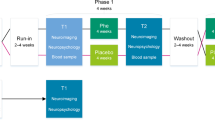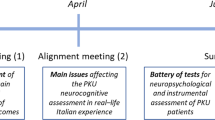Abstract
Summary: Adult subjects with classical phenylketonuria (PKU) who were diagnosed and treated neonatally participated in this long-term follow-up study. Twenty-four subjects received neuropsychological (NP) assessment and a subset received magnetic resonance imaging (MRI) and magnetic resonance spectroscopy (MRS) to identify: (1) pattern of cognitive dysfunction; (2) effect of high blood phenylalanine (Phe) level at time of cognitive testing; and (3) treatment variables that may be associated with cognitive difficulties in adulthood. All subjects had average IQ except one subject in the borderline range. Diet was initiated by the 15th day of life. All subjects except one were on diet until age 6 years (mean years of treatment = 15). Blood Phe levels at cognitive testing ranged from 157 to 1713 µmol/L (mean = 1038); 11 subjects had levels >1000 µmol/L and 13 subjects had levels >;1000 µmol/L. Results suggest that adults with early-treated PKU demonstrate specific cognitive deficits, a number of which are associated with the frontal and temporal area of the brain. Deficits were noted in several domains including executive functioning, attention, verbal memory, expressive naming and verbal fluency. Self-report measures of depression and anxiety were generally in the normal/mild range. The group with a Phe level >;1000 µmol/L scored lower than the group with Phe level <1000 µmol/L on measures of focused attention, verbal fluency, reaction time, verbal recognition memory, visual memory and naming. Tests of cognitive functioning were often correlated with measures of treatment during childhood rather than with Phe level at the time of cognitive testing. Subjects with abnormal MRI scored significantly lower on two cognitive tests (Trails A and CVLT Recognition Memory). We found no significant correlation between current brain Phe level obtained through MRS (n = 10) and neuropsychological functioning. Future longitudinal investigation with a larger sample size will assist in clarifying the aetiology of neuropsychological deficits and association with treatment history.
Similar content being viewed by others
REFERENCES
Beck AT, Steer RA (1990) Beck Anxiety Inventory.San Antonio: The Psychological Corporation.
Beck AT, Steer RA (1993) Beck Depression Inventory.San Antonio: The Psychological Corporation.
Bornstein RA (1985) Normative data on selected neuropsychological measures from a nonclinical sample. J Clin Psychol41: 651–658.
Brunner RL, Berry HK (1987) Phenylketonuria and sustained attention: the continuous performance test. Int J Clin Neuropsychol9: 68–70.
Chamove AS, Molinaro TJ (1978) Monkey retarded learning analysis. J Ment Defic Res22: 37–48.
Connors CK and Multi-Health Systems Staff (1995) Connors' Continuous Performance Test Version 3.1.Toronto: Multi-Health Systems.
Delis DC, Kramer JH, Kaplan E, Ober BA (1987) California Verbal Learning Test Adult Version Manual.San Antonio: The Psychological Corporation.
Diamond A (2001) A model system for studying the role of dopamine in the prefrontal cortex during early development in humans: early and continuously treated phenylketonuria. In: Handbook of Developmental Cognitive Neuroscience.Cambridge, MA: MIT Press, 433–472.
Diamond A, Prevor MB, Callender G, Druin DP (1997) Prefrontal cortex cognitive deficits in children treated early and continuously for PKU. Monogr Soc Res Child Dev62: i-v, 1–208.
Dunn LM, Dunn LM (1997) Peabody Picture Vocabulary Test Third Edition.Circle Pines: American Guidance Service.
Feldmann R, Denecke J, Pietsch M, Grenzebach M, Weglage J (2002) Phenylketonuria: no specific frontal lobe-dependent neuropsychological deficits of early-treated patients in comparison with diabetics. Pediatr Res51: 761–765.
Griffiths P, Campbell R, Robinson P (1998) Executive function in treated phenylketonuria as measured by the one-back and two-back versions of the continuous performance test. J Inherit Metab Dis21: 125–135.
Guldberg P, Rey F, Zschocke J, et al (1998) A European multicenter study of phenylalanine hydroxylase deficiency: classification of 105 mutations and a general system for genotype-based prediction of metabolic phenotype. Am J Hum Genet63: 71–79.
Heaton RK, Chelune GJ, Talley JL, Kay GG, Curtiss G (1993) Wisconsin Card Sorting Test Manual Revised and Expanded.Odessa: Psychological Assessment Resources.
Kapalan EF, Goodglass H, Weintraub S (1983) The Boston Naming Test.Philadelphia: Lea and Febiger.
Koch R, Burton B, Hoganson G, et al (2002) Phenylketonuria in adulthood: a collaborative study. J Inherit Metab Dis25: 333–346.
Mathews CG, Klove H (1964) Instructions Manual for the Adult Neuropsychology Test Battery. Madison: University of Wisconsin Medical School.
Mazzocco MMM, Nord AM, van Doorninck WJ, Greene CL, Kovar CG, Pennington BF (1994) Cognitive development among children with early-treated phenylketonuria. Dev Neuropsychol10: 133–151.
Mitrushina MN, Boone KB, D'Elia LF (1999) Handbook of Normative Data for Neuropsychological Assessment.New York: Oxford University Press.
Moats RA, Koch R, Moseley K, et al (2000) Brain phenylalanine concentration in the management of adults with phenylketonuria. J Inherit Metab Dis23: 7–14.
Moller HE, Weglage J, Bick U, Wiedermann D, Feldmann R, Ullrich K (2003) Brain imaging and proton magnetic resonance spectroscopy in patients with phenylketonuria. Pediatrics112: 1580–1583.
Partington JE, Leiter RG (1949) Partington's pathway test. Psychol Serv Cntr Bull1: 9–20.
Pennington BF, van Doorninck WJ, McCabe LL, McCabe ER (1985) Neuropsychological deficits in early treated phenylketonuric children. Am J Ment Defic89: 467–474.
Pietz J, Schmidt E, Matthis P, Kobialka B, Kutscha A, de Sonneville L (1993) EEGs in phenylketonuria. I: Follow-up to adulthood; II: Short-term diet-related changes in EEGs and cognitive function. Dev Med Child Neurol35: 54–64.
Pietz J, Dunckelmann R, Rupp A, et al (1998) Neurological outcome in adult patients with early-treated phenylketonuria. Eur J Pediatr157: 824–830.
Porrino LJ, Goldman-Rakic PS (1982) Brainstem innervation of prefrontal and anterior cingulate cortex in the rhesus monkey revealed by retrograde transport of HRP. J Comp Neurol205: 63–76.
Ris MD, Williams SE, Hunt MM, Berry HK, Leslie N (1994) Early-treated phenylketonuria: adult neuropsychologic outcome. J Pediatr124: 388–392.
Schmidt E, Rupp A, Burgard P, Pietz J, Weglage J, de Sonneville L (1994) Sustained attention in adult phenylketonuria: the in?uence of the concurrent phenylalanine-blood-level. J Clin Exp Neuropsychol16: 681–688.
Scriver CR, Kaufman S, Eisensmith RC, Woo SLCL (1995) The hyperphenylalaninemias. In: Scriver CR, Baudet AL, Sly WS, Valle D, eds. The Metabolic and Molecular Bases of Inherited Disease, 7th Edn. New York: McGraw Hill, 1015–1075.
Smith ML, Klim P, Mallozzi E, Hanley WB (1996) A test of frontal-specificity hypothesis in the cognitive performance of adults with phenylketonuria. Dev Neuropsychol12: 327–341.
Spreen O, Benton AL (1977) Neurosensory Center Comprehensive Examination for Aphasia.Victoria: University of Victoria Neuropsychology Laboratory.
Spreen O, Strauss E (1998) A Compendium of Neuropsychological Tests.New York: Oxford University Press.
Spreen O, Tupper D, Risser A, Tuokko H, Edgell D (1984) Human Developmental Neuropsychology.New York: Oxford University Press.
Stemerdink NB (2000) Comments on neuropsychological approaches to treatment policy issues in phenylketonuria. Eur J Pediatr159(supplement 2): S87–88.
US-DHHS (2001) Report of the NIH Consensus Development Conference on Phenylketonuria (PKU): Screening and Management. US Department of Health and Human Services, Public Health Service, National Institutes of Health, National Institute of Child Health and Human Development.
Wechsler D (1981) TheWechsler Adult Intelligence Scale-Revised.NewYork: The Psychological Corporation.
Weglage J, Pietsch M, Funders B, Koch HG, Ullrich K (1996) Deficits in selective and sustained attention processes in early treated children with phenylketonuriaQresult of impaired frontal lobe functions? Eur J Pediatr155: 200–204.
Welsh MC, Pennington BF, Ozonoff S, Rouse B, McCabe ER (1990) Neuropsychology of early-treated phenylketonuria: specific executive function deficits. Child Dev61: 1697–1713.
White DA, Nortz MJ, Mandernach T, Huntington K, Steiner RD (2001) Deficits in memory strategy use related to prefrontal dysfunction during early development: evidence from children with phenylketonuria. Neuropsychology15: 221–229.
White DA, Nortz MJ, Mandernach T, Huntington K, Steiner RD (2002) Age-related working memory impairments in children with prefrontal dysfunction associated with phenylketonuria. J Int Neuropsychol Soc8: 1–11.
Williamson ML, Koch R, Azen C, Chang C (1981) Correlates of intelligence test results in treated phenylketonuric children. Pediatrics68: 161–167.
Yeudall LT, FrommD, Reddon JR, StefanykWO (1986) Normative data stratified by age and sex for 12 neuropsychological tests. J Clin Psychol42: 918–946.
Yeudall LT, Reddon JR, Gill DM, Stefanyk WO (1987) Normative data for the Halstead-Reitan neuropsychological tests stratified by age and sex. J Clin Psychol43: 346–367.
Zellerstrom R (1995) Editorial comment on phenylketonuria. Acta Pediatrica84: 716–718.
Author information
Authors and Affiliations
Rights and permissions
About this article
Cite this article
Brumm, V.L., Azen, C., Moats, R.A. et al. Neuropsychological outcome of subjects participating in the PKU Adult Collaborative Study: A preliminary review. J Inherit Metab Dis 27, 549–566 (2004). https://doi.org/10.1023/B:BOLI.0000042985.02049.ff
Issue Date:
DOI: https://doi.org/10.1023/B:BOLI.0000042985.02049.ff




